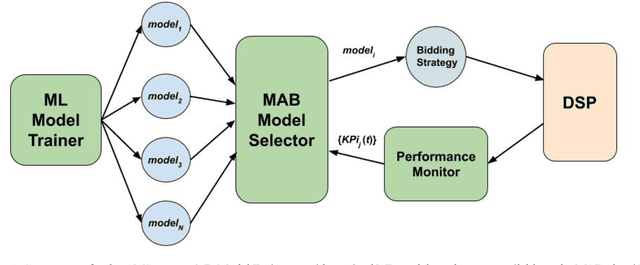Rouzbeh Gerami
Techniques Toward Optimizing Viewability in RTB Ad Campaigns Using Reinforcement Learning
May 21, 2021



Abstract:Reinforcement learning (RL) is an effective technique for training decision-making agents through interactions with their environment. The advent of deep learning has been associated with highly notable successes with sequential decision making problems - such as defeating some of the highest-ranked human players at Go. In digital advertising, real-time bidding (RTB) is a common method of allocating advertising inventory through real-time auctions. Bidding strategies need to incorporate logic for dynamically adjusting parameters in order to deliver pre-assigned campaign goals. Here we discuss techniques toward using RL to train bidding agents. As a campaign metric we particularly focused on viewability: the percentage of inventory which goes on to be viewed by an end user. This paper is presented as a survey of techniques and experiments which we developed through the course of this research. We discuss expanding our training data to include edge cases by training on simulated interactions. We discuss the experimental results comparing the performance of several promising RL algorithms, and an approach to hyperparameter optimization of an actor/critic training pipeline through Bayesian optimization. Finally, we present live-traffic tests of some of our RL agents against a rule-based feedback-control approach, demonstrating the potential for this method as well as areas for further improvement. This paper therefore presents an arrangement of our findings in this quickly developing field, and ways that it can be applied to an RTB use case.
Online and Scalable Model Selection with Multi-Armed Bandits
Jan 25, 2021


Abstract:Many online applications running on live traffic are powered by machine learning models, for which training, validation, and hyper-parameter tuning are conducted on historical data. However, it is common for models demonstrating strong performance in offline analysis to yield poorer performance when deployed online. This problem is a consequence of the difficulty of training on historical data in non-stationary environments. Moreover, the machine learning metrics used for model selection may not sufficiently correlate with real-world business metrics used to determine the success of the applications being tested. These problems are particularly prominent in the Real-Time Bidding (RTB) domain, in which ML models power bidding strategies, and a change in models will likely affect performance of the advertising campaigns. In this work, we present Automatic Model Selector (AMS), a system for scalable online selection of RTB bidding strategies based on real-world performance metrics. AMS employs Multi-Armed Bandits (MAB) to near-simultaneously run and evaluate multiple models against live traffic, allocating the most traffic to the best-performing models while decreasing traffic to those with poorer online performance, thereby minimizing the impact of inferior models on overall campaign performance. The reliance on offline data is avoided, instead making model selections on a case-by-case basis according to actionable business goals. AMS allows new models to be safely introduced into live campaigns as soon as they are developed, minimizing the risk to overall performance. In live-traffic tests on multiple ad campaigns, the AMS system proved highly effective at improving ad campaign performance.
 Add to Chrome
Add to Chrome Add to Firefox
Add to Firefox Add to Edge
Add to Edge